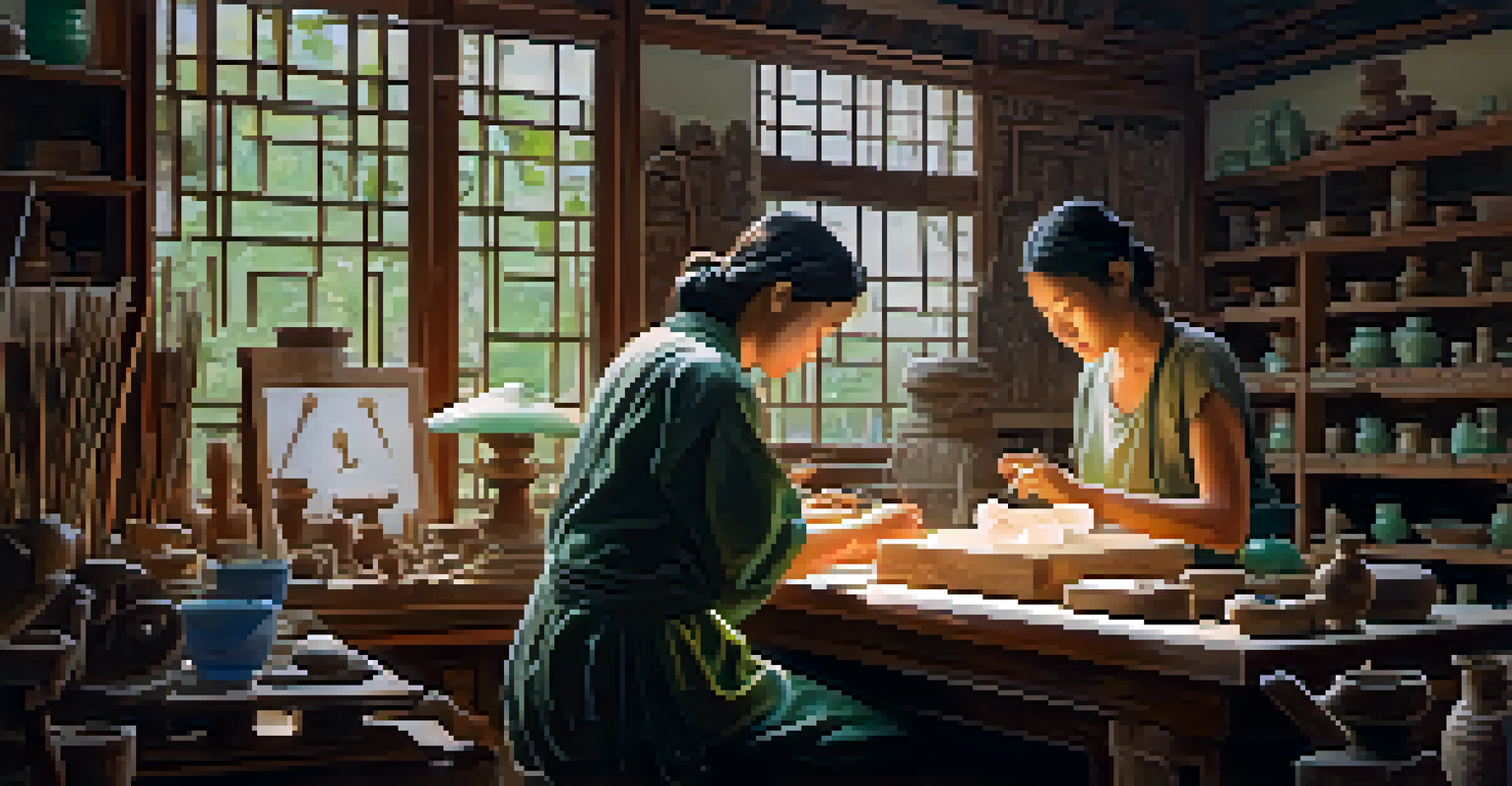Carving Techniques: A Bridge Between Diverse Cultures

The Rich History of Carving Across Cultures
Carving has been a form of expression for centuries, with roots that trace back to ancient civilizations. From the intricate totem poles of Native American tribes to the delicate jade carvings of Chinese artisans, each piece tells a story of its origin. This art form serves as a historical record, reflecting the values, beliefs, and practices of various cultures. Carving techniques not only showcase the skill of the artist but also preserve the heritage of their communities.
Art is the most beautiful of all lies.
In many cultures, carvings are imbued with spiritual significance. For example, African masks often represent spirits or ancestors, playing a vital role in rituals and ceremonies. Similarly, the Maori of New Zealand use intricate carving to depict their lineage and tell tales of their ancestors. Such cultural representations emphasize the deep connection between carving and identity, making it a powerful medium for storytelling.
As we explore the world of carving, we uncover a tapestry of traditions that reveal how communities have adapted techniques over time. While each culture has its unique methods and materials, the underlying purpose remains the same: to create art that resonates with people. This shared passion for carving acts as a bridge, linking diverse cultures through a universal language of creativity.
Materials and Tools: A Journey Through Time
The materials used in carving can vary widely, reflecting the resources available in each culture. Wood, stone, bone, and ivory are among the most common materials, each offering unique properties and challenges. For instance, hardwoods like mahogany are favored for their durability and rich grain, while softer woods allow for finer detail and easier manipulation. The choice of material not only affects the final product but also influences the carving techniques employed.

Tools have evolved significantly across cultures and time periods, shaping the way artists approach their craft. Traditional hand tools, such as chisels and gouges, have been used for centuries, while modern technology has introduced power tools that increase efficiency. However, many artisans still prefer traditional methods for the connection they foster with their craft. This blend of old and new reflects the ongoing dialogue between heritage and innovation.
Carving Preserves Cultural Heritage
Carving serves as a vital medium for preserving cultural narratives and identities in a rapidly globalizing world.
Understanding the materials and tools of carving provides insight into the artistic process and the cultural significance behind it. Each tool and medium carries its own narrative, shaping the final artwork and the stories it tells. As carvers continue to explore new techniques and materials, they contribute to a rich legacy that honors tradition while embracing change.
Symbolism in Carving: More Than Meets the Eye
Carvings often carry deep symbolic meanings, making them powerful tools for communication. For example, in Celtic culture, intricate knotwork symbolizes the interconnectedness of life, while many Indigenous carvings feature animals that represent particular traits or teachings. This use of symbolism allows for a richer understanding of the culture that produced the work, inviting viewers to engage with the art on a deeper level.
Every artist dips his brush in his own soul, and paints his own nature into his pictures.
In some cultures, specific motifs are used to convey blessings or protection. For instance, the Hamsa hand in Middle Eastern cultures is a popular symbol carved into jewelry and home decor, believed to ward off evil. By incorporating such symbols into their work, artisans connect with their cultural beliefs and share these ideas with others. This creates a sense of continuity and community among those who appreciate the art.
As we analyze the symbolism behind various carvings, we begin to see how these images transcend time and geography. They become a language of their own, conveying messages that resonate across generations and cultures. This shared understanding reinforces the idea that, while carving techniques may differ, the emotions and stories they express are universal.
Traditional vs. Contemporary Carving Techniques
While traditional carving techniques have been passed down through generations, contemporary artists often blend these methods with modern influences. Traditional techniques are characterized by their adherence to cultural norms and practices, which can include specific tools, styles, and subjects. For example, the intricate wood carvings of the Inuit people remain largely unchanged, reflecting their heritage and traditions.
In contrast, contemporary carving may incorporate mixed media or abstract concepts, allowing artists to push boundaries and explore new ideas. This fusion of styles not only expands the definition of carving but also invites a broader audience to engage with the art form. Many modern carvers draw inspiration from their cultural roots while also experimenting with innovative techniques, resulting in a dynamic interplay between past and present.
Symbolism Enhances Artistic Meaning
Many carvings incorporate deep symbolic meanings that invite viewers to connect with the culture and stories behind the art.
The evolution of carving techniques highlights the fluidity of artistic expression, as artists continuously adapt to their environments and societal changes. This ongoing dialogue between traditional and contemporary practices enriches the carving landscape, ensuring that it remains relevant and vibrant. Ultimately, this blending of styles serves as a testament to the resilience and creativity of cultures around the world.
Carving as a Medium for Cultural Preservation
In an age of globalization, carving has emerged as a vital tool for cultural preservation. As traditional practices face the threat of extinction, many artisans are revitalizing their heritage through carving. This resurgence not only keeps cultural narratives alive but also fosters a sense of pride and identity within communities. By passing down skills, stories, and techniques, carvers ensure that future generations remain connected to their ancestry.
Organizations and initiatives dedicated to preserving carving traditions have also emerged, providing resources and support to artisans worldwide. These efforts include workshops, exhibitions, and mentorship programs that promote the importance of cultural heritage. This collaborative spirit not only strengthens communities but also encourages intercultural dialogue, allowing for a richer understanding of global artistry.
The role of carving in cultural preservation emphasizes its significance beyond mere aesthetics. Each carved piece serves as a reminder of a culture's history, values, and beliefs, offering insight into the lives of those who came before us. By recognizing the importance of carving as a medium for cultural expression, we can appreciate the artistry while honoring the stories behind the craft.
Carving Techniques in Modern Art and Design
In recent years, carving techniques have found their way into modern art and design, bridging the gap between traditional craftsmanship and contemporary aesthetics. Artists and designers are increasingly integrating carving into furniture, sculpture, and home decor, infusing these pieces with cultural significance and personal narrative. This trend not only elevates the status of carving but also highlights its versatility as an art form.
By utilizing carving in modern designs, creators are able to pay homage to traditional techniques while appealing to a contemporary audience. This fusion often results in unique, one-of-a-kind pieces that resonate with consumers who value both artistry and cultural storytelling. As a result, carving has become a sought-after technique in the world of interior design and high-end art.
Tradition Meets Modern Innovation
Contemporary artists blend traditional carving techniques with modern influences, creating unique pieces that resonate with a diverse audience.
The incorporation of carving into modern art reflects a growing appreciation for handmade craftsmanship and the stories behind each piece. As artists explore new themes and styles, they continue to draw inspiration from their cultural roots, ensuring that the art of carving remains relevant in today's fast-paced world. This evolution not only enriches the artistic landscape but also fosters a deeper connection between viewers and the cultural narratives embedded in the work.
The Future of Carving: Trends and Innovations
As we look toward the future of carving, several trends and innovations are shaping the landscape. Technology plays a significant role, with digital tools and software enabling artists to experiment with new designs and techniques. CNC machines, for instance, have transformed the way carvings are produced, allowing for precision and detail that were once unimaginable. However, many artisans still prioritize traditional methods, finding value in the tactile nature of hand-carving.
Sustainability is also becoming a key focus in the carving community, as artists seek to use eco-friendly materials and practices. This shift reflects a growing awareness of environmental issues and the importance of preserving natural resources. By prioritizing sustainable practices, carvers not only contribute to a healthier planet but also ensure the longevity of their craft. This commitment to responsible artistry resonates with consumers who are increasingly mindful of their choices.

Ultimately, the future of carving is an exciting blend of tradition and innovation. As artists continue to explore new techniques and materials, they will undoubtedly push the boundaries of this age-old craft. By embracing both the past and the present, carving can continue to serve as a bridge between diverse cultures, fostering understanding and appreciation for the artistry that transcends borders.